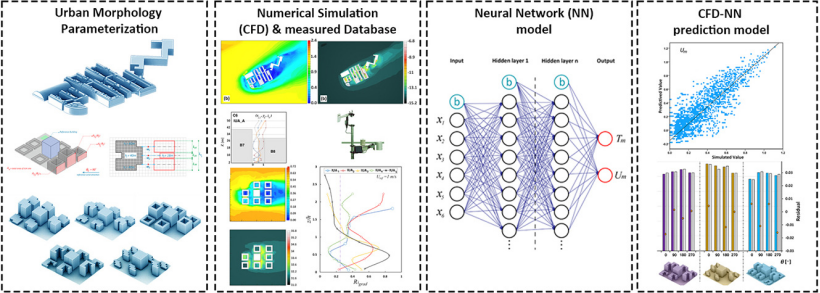品质至上,客户至上,您的满意就是我们的目标
应用案例
当前位置: 首页 > 应用案例
Pessl气象工作站:气候和城市形态之间的复杂相互作用
发表时间:2022-03-21 10:29:16点击:1269
来源:北京博普特科技有限公司
分享:
结合计算流体力学和神经网络描述极端小气候:学习气候和城市形态之间的复杂相互作用
热点
使用CFD和神经网络降低极端天气尺度的数据驱动模型
通过高分辨率现场测量验证了数值模拟的有效性。
一种新的城市冠层参数化方法
该模型在预测极端小气候条件方面是可靠的。
该模型可用于城市能源和舒适性研究。
摘要
城市形态和极端小气候事件会对建筑物的能源性能、城市舒适性和人类健康产生重要影响。最先进的建筑能耗模拟需要有关城市小气候的信息,但通常依赖特别的数值模拟、昂贵的现场测量或附近气象站的数据。因没有考虑到可能的城市小气候变化的全部范围,研究结果不能在城市形态中概括。为了弥补这一知识差距,本研究提出了两个数据驱动的模型,将任意城市形态中的气候变量从中等尺度降到微观尺度,重点关注极端气候条件。这些模型基于前馈和深度神经网络(NN)体系结构,并使用计算流体力学(CFD)模拟的结果对其进行训练,这些模拟的对象是一系列理想但具有代表性的城市环境,涵盖了一系列真实的城市形态。这两个模型与相应的CFD训练数据具有相对较好的一致性,确定系数为R2 = 0.89(R2 = 0.91)和R2 = 0.92(R2 = 0.94),用于前馈神经网络(深度神经网络)的空间分布风速和气温。该模型适用于参数空间训练范围内的未知城市形态和中尺度输入数据,R2 = 0.89(R2 = 0.91)和R2 = 0.92(R2 = 0.94),用于前馈NN(深度NN)的风力大小和空气温度。所提出的CFD-NN模型的准确性和效率使其非常适合在早期设计阶段设计气候适应性强的建筑。
Combining computational fluid dynamics and neural networks to characterize microclimate extremes: Learning the complex interactions between meso-climate and urban morphology

Highlights
A data-driven model to downscale weather extremes using CFD and Neural-Networks
Numerical simulations are validated against high-resolution in-situ measurements.
A novel urban canopy parameterization method developed to model urban morphologies
The model probed reliable in predicting extreme microclimate conditions.
The model can be readily used in urban-energy and -comfort studies.
Abstract
The urban form and extreme microclimate events can have an important impact on the energy performance of buildings, urban comfort and human health. State-of-the-art building energy simulations require information on the urban microclimate, but typically rely on ad-hoc numerical simulations, expensive in-situ measurements, or data from nearby weather stations. As such, they do not account for the full range of possible urban microclimate variability and findings cannot be generalized across urban morphologies. To bridge this knowledge gap, this study proposes two data-driven models to downscale climate variables from the meso to the micro scale in arbitrary urban morphologies, with a focus on extreme climate conditions. The models are based on a feedforward and a deep neural network (NN) architecture, and are trained using results from computational fluid dynamics (CFD) simulations of flow over a series of idealized but representative urban environments, spanning a realistic range of urban morphologies. Both models feature a relatively good agreement with corresponding CFD training data, with a coefficient of determination R2 = 0.89 (R2 = 0.91) and R2 = 0.92 (R2 = 0.94) for spatially-distributed wind magnitude and air temperature for the feedforward NN (deep NN). The models generalize well for unseen urban morphologies and mesoscale input data that are within the training bounds in the parameter space, with a R2 = 0.89 (R2 = 0.91) and R2 = 0.92 (R2 = 0.94) for wind magnitude and air temperature for the feedforward NN (deep NN). The accuracy and efficiency of the proposed CFD-NN models makes them well suited for the design of climate-resilient buildings at the early design stage.